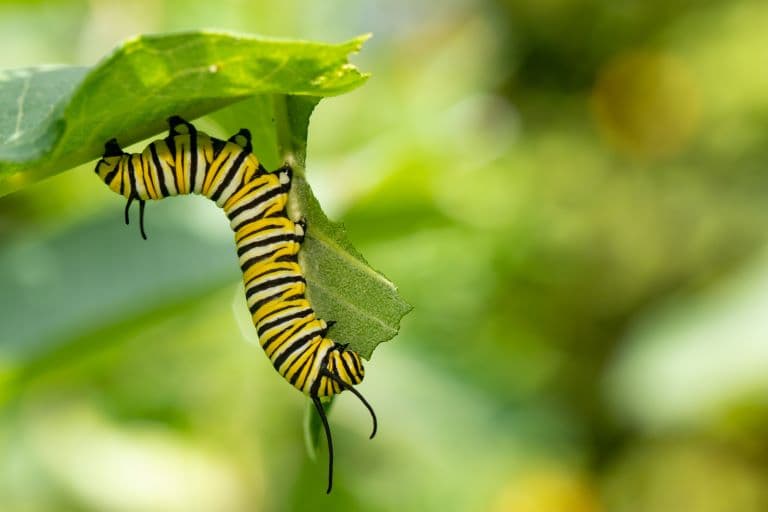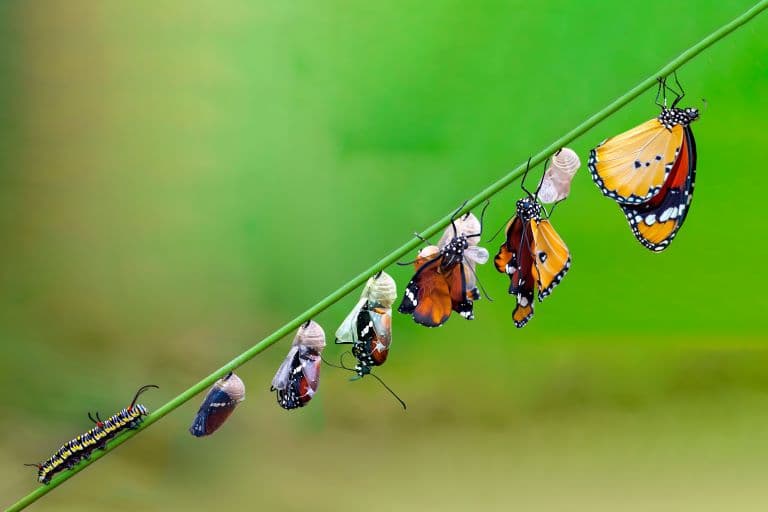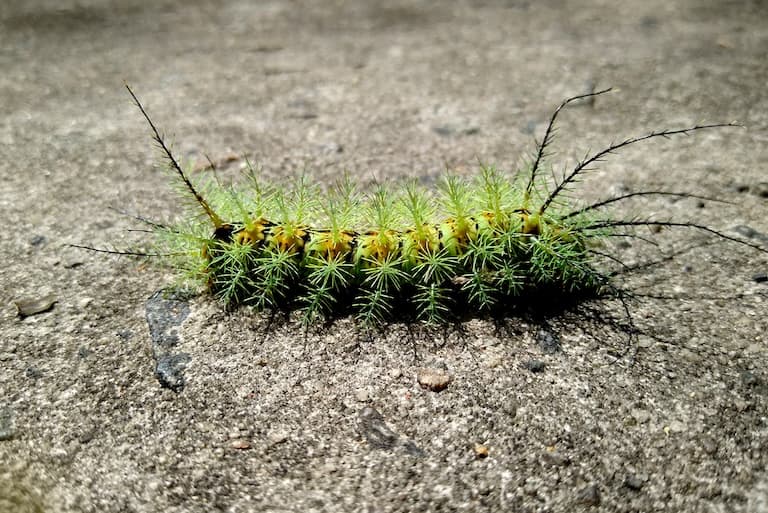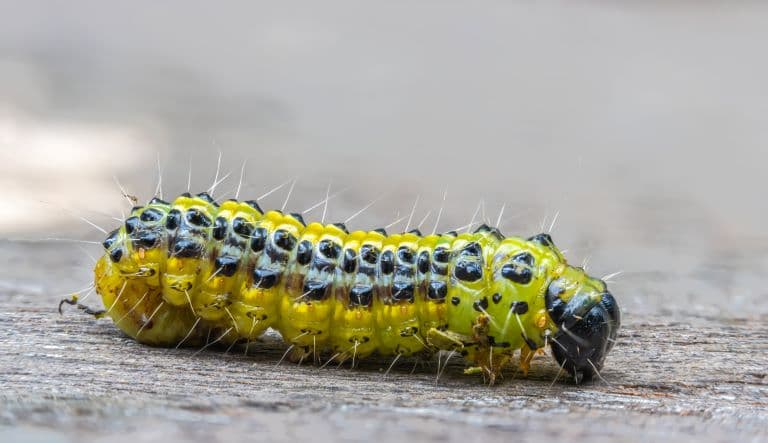Caterpillar Profile
The classic four-stage insect development goes: egg-larva-[MAGIC]-adult; and it’s one that’s used by more than 80% of insects, so it’s clearly a popular choice.
The pupation stage is a miracle of tissue reorganisation, a biological scrambling of the fat maggoty body and redistribution into wings and hairs and pretty colours. The larval stage involves lots of pulsing and writhing and general meaty wriggling.
When flies do this, we get appalled. But when butterflies and moths do it, we’re somehow fine with that. So, what’s the difference? Why is a maggot different from a caterpillar and why do we find a larva less gross when it grows wings and flaps around in our faces?

Caterpillar Facts Overview
| Habitat: | Varied |
| Location: | All continents except Antarctica |
| Lifespan: | Up to 14 years |
| Size: | Up to 15cm (6 inches) |
| Weight: | More than 30g |
| Colour: | Highly variable, from plain to vivid colours |
| Diet: | Usually plants, some are carnivorous |
| Predators: | Almost everything that eats insects |
| Top Speed: | Slow |
| No. of Species: | 180,000+ |
| Conservation Status: | Least Concern to Critically Endangered (IUCN) |
Caterpillars are some of the most significant insects in the world, both in terms of their ecological impact and their economic relevance to human systems.
They are, as you’d expect, as diverse as the flappy insects they eventually become, yet their juicy, fat and wriggly nature doesn’t appeal to quite as many people. And while their lifecycle is commonly described in four stages, caterpillars do need to shed their skins multiple times during their growth.
Caterpillars are where moths and butterflies spend most of their lives, and they’re just as, if not more, incredible and diverse than the brief reproductive stage they’re known for.
Interesting Caterpillar Facts
1. They’re the true state butterflies
Imagine working your whole life, quietly mastering the craft of something you love and perfecting it until your final days, at which point you make a highly popular 3-minute YouTube video about something entirely unrelated and this becomes what you’re known for.
Butterflies and moths do life in reverse. They spend the vast majority of their existence living it up: Eating, sleeping, just wallowing in immaturity until they approach the end of their lives when they quickly pupate, emerge as sexually mature, winged adults, mate, and die.
The butterfly stage is therefore more of an afterthought, yet this is what they’re primarily known for because they flutter about majestically with pretty patterns on their wings. But this seems unfair to the caterpillar – the one who did all the work and played the more significant role in the ecosystem.

2. They’re diverse
There are almost 200,000 species of lepidopterans known, each identified by their brief viral video stage, but each with a corresponding usually overlooked caterpillar stage.
In the same way that butterflies and moths come in all colours and sizes, so do caterpillars. From the tiny citrus leaf miners, who are the bane of orange farmers (and indeed regular-coloured farmers of citrus crops), to the six-inch hickory horned devil caterpillar that comes packing a set of enormous appendages.
Size and shape aren’t the only variables in caterpillars, either. While many are dull browns and greens, others are incredible snake mimics with huge eye spots or hairy fluff balls with rainbow stripes.
Some are even extremely dangerous! 1
3. Some are venomous
One of the fluffier varieties, Lonomia obliqua, is by no means a cuddly fella. This caterpillar has urticating hairs, the kind you might find in an angry New World tarantula. Unlike the tarantulas, however, these can kill you.
Its highly toxic venom can prevent your blood from coagulating and make it so thin it leaks out between your tissues. This isn’t what you want your blood to do, of course, and should be avoided.
This caterpillar has killed and will kill again, and it’s not the only one. It’s known as the silkworm moth, and this is a name given to a bunch of moths whose caterpillars produce one of the finest textiles known to man.

4. Some make silk
During pupation, caterpillars typically spin themselves into a protective cocoon. In some species, this has become an irony, in that it is the very protective mass that drew human attention.
Like spiders, caterpillars have spinnerets, but they’re usually found at the other end, on their faces. Their mouths extrude liquid silk from modified salivary glands, passing through a line of fluid that dries on contact with the air.
Some species make such high-quality silk that people started boiling the helpless animals inside their cocoons and extracting it to weave into, well, silk.
5. They have pseudo-legs
On emerging from its egg, a new caterpillar eats the shell, giving the animal its first injection of nutrition from the outside world.
Then, it goes off on its merry way, wriggling about quite effectively for a tube of leaf-processing gut with just three legs at the front.
That’s because it has a set of eight fake legs at the back. These pseudopods, or prolegs aren’t jointed and don’t have a lot of mobility, but they do function well to stick to things and create leverage. They’re controlled through hydraulic pressure, yet another similarity to spider locomotion!
When the prolegs are busy, there’s also a pair of anal claspers, used to grab hold of things. 2
6. They have Spiracles
Along the length of this walking digestive system is a line of tiny holes, known as spiracles. In the absence of breathing apparatus, caterpillars absorb oxygen through their skin.
These holes are connected to multiple tracheae, just like your one breathing hole is connected to yours! Instead of lungs, though, they have small air sacs that expand and contract with the pulsing movements of their body to draw in and expel air.
These structures are some of the few that will remain intact during metamorphosis, while much of the rest of the body is broken down and reconfigured.

7. They feed everything
Before this, though, they’ll spend almost their entire existence eating. This is what makes caterpillars so incredibly important to their ecology and to the human economy.
Their biomass alone provides food for a dazzling array of animals from insects to mammals, birds, reptiles, amphibians, and even crabs, scorpions and spiders.
So they provide a lot of animals with a constant food supply, as well as putting significant selective pressure on their plant hosts. 3
8. And they feed on everything
Outside of a few useful examples like the silkworm, most caterpillars are considered pests, but their sheer number and diversity are significant.
For almost every vegetable, there is a corresponding caterpillar who will happily destroy it. As such, caterpillars remain one of the greatest pests to human agriculture. And there’s no escaping them! 4
9. Some live in the Arctic
Most caterpillars come from warmer regions, but they’re so widespread they can be found as far North as Greenland.
Woolly bear caterpillars survive the exceptional cold by becoming dormant during the worst of it, and can withstand temperatures as frigid as -60C!
This cold life is also a slow one, and the caterpillar can live for 14 years before pupating. 5
Caterpillar Fact-File Summary
Scientific Classification
| Kingdom: | Animalia |
| Phylum: | Arthropoda |
| Class: | Insecta |
| Order: | Lepidoptera |
| Family: | 120+ families |
Fact Sources & References
- “Pests in Gardens and Landscapes”, Agriculture and Natural Resources, University of California.
- Katie Piercy (2022), “Caterpillar Breathing Explained (What Are Spiracles?)”, meadowia.
- “Caterpillars, Biodiversity, and You!”, Cathance River Education Alliance.
- “Caterpillars”, Ausveg.
- “Arctic creepy-crawlies part I: the ice worms”, Scientific American.
